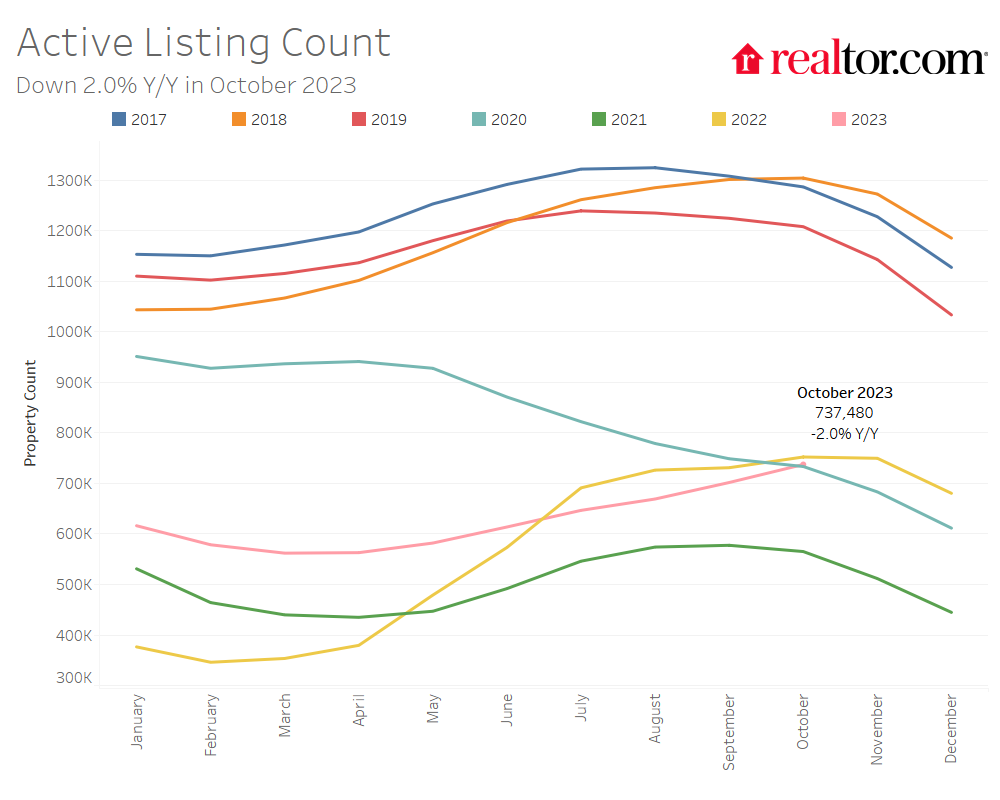 Amid a larger inventory drought and increasing mortgage rates, Realtor.com reported that October home prices held steady from the previous month as the number of homes actively for sale shrank 2% on an annual basis for the fourth consecutive month.
Amid a larger inventory drought and increasing mortgage rates, Realtor.com reported that October home prices held steady from the previous month as the number of homes actively for sale shrank 2% on an annual basis for the fourth consecutive month.
However, and more notably, there was an unexpected and unseasonable increase of available inventory during the month (5.1%) even as rates exceeded 20-year highs.
Notably, while home prices stayed flat, the share of price reductions, while down year over year, continued to grow on a monthly basis, indicating that home prices could potentially soften in the coming months.
"The current housing market continues to challenge homebuyers and sellers alike, but we do see signs of adjustment," said Danielle Hale, Chief Economist at Realtor.com. "While record-high mortgage rates are putting off many would-be buyers, decreases in both inventory and time homes spend on the market shows that some buyers are moving quickly to lock in rates before they can go any higher. Buyers did see some measure of relief in stable home prices this month, and we'll be watching the rising share of listings with reduced prices to see how that impacts prices in the near future."

So, what does this mean for the common homebuyer, seller, and the market in general? To start, inventory is now down 41.8% below pre-pandemic levels, and along with ever-increasing home prices, continue to deter potential homebuyers as we move into November.
A few relatively unusual monthly data points are worth watching, such as late-season growth in the inventory of homes for sale at a time when it would typically decline, along with the rising share of price reductions, which could signal a softness in prices in the coming months.
According to Realtor.com, easing prices would be encouraging news for buyers, as much-higher mortgage rates compared to last October have increased the monthly cost of financing 80% of the typical home by roughly $166 (+7.4%) compared to one year ago, bringing it to a high not previously seen in Realtor.com data that stretches back to mid-2016. In practical terms, this means households looking to purchase the median-priced home in October now need an additional $6,600 in annual income ($120,000) compared to the same time last year.
"Because high mortgage rates, elevated home prices, and stubbornly low inventory make today's housing market particularly challenging, many of today's buyers are motivated by life changes, such as growing families, supporting elderly parents or grown children, or accommodating professional needs, from return to office mandates to relocation opportunities created by remote work," said Realtor.com's Executive News Editor Clare Trapasso. "On a positive note, our data shows that home shoppers with flexibility in their location choices can still find affordable options this fall."

Click here to see the report in its entirety.

 theMReport.com Your trusted source for mortgage banking news
theMReport.com Your trusted source for mortgage banking news








